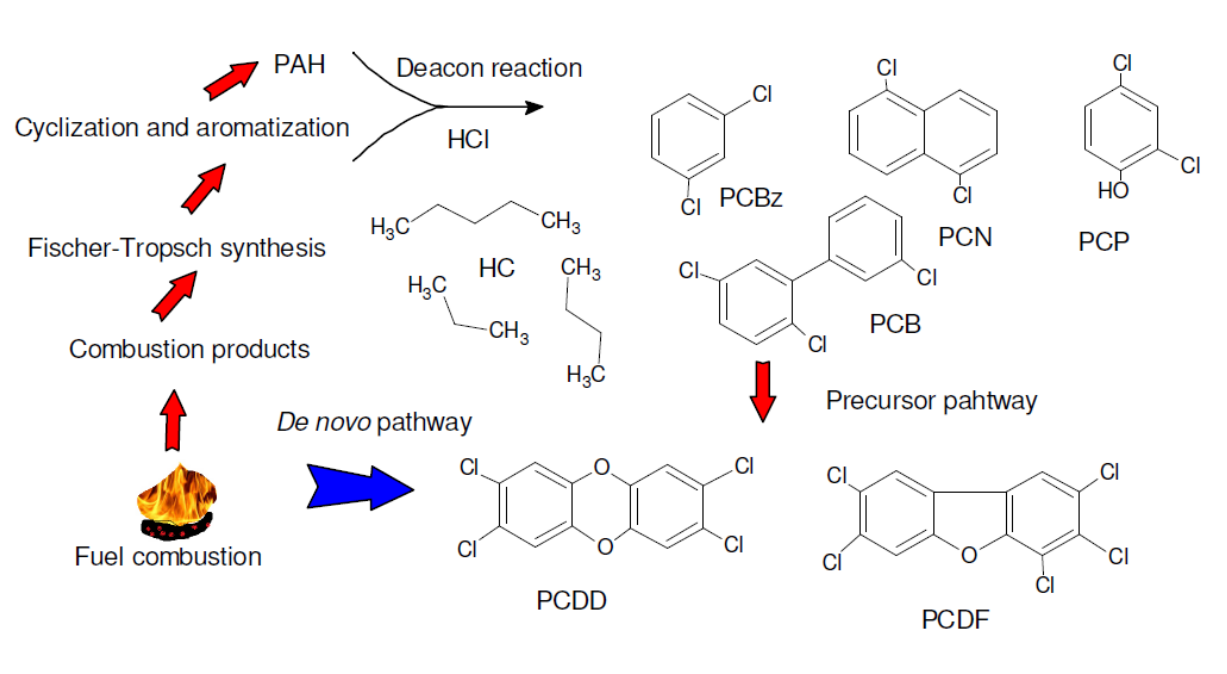Fuel modification based on some metals compounds and their environmental impact
DOI:
https://doi.org/10.5604/01.3001.0012.1152Keywords:
metals, combustion, pollution, air, solid, additives, coal, petrolAbstract
The history of fuel additive use reflects the interplay between chemistry, technology and public health concerns related to environmental effects. Decisions to use specific type of chemical modification during combustion process have been made in the absence of toxicological data on health and environmental effects or exposure. The influence of these important issues has extended globally, and the effects of various compositions impact for decades after the removal of these compounds. Fuel modifications are widely used for petrol, oil and solid fuels. According to market screening and literature review, additives containing some dangerous compounds are still in used today. Pb(C2H5)4 was used for long time as fuel additive and is still used as an additive in some grades of aviation gasoline, and in some developing countries. It is obvious that additives containing copper, lead and cerium should be replaced by organic substitutes or inorganic oxidizers during combustion processes.
Downloads
References
Dale JG, Cox SS, Vance ME, Marr LC, Hochella MC: Transformation of cerium oxide nanoparticles from a diesel fuel additive during combustion in a diesel engine. Environ. Sci. Technol. 2017, 51, 1973–1980. doi: https://doi.org/10.1021/acs.est.6b03173. Google Scholar
Yang WM, An H, Chou SK, Vedharaji S, Vallinagam R, Balaji M, Mohammad FEA, Chua KJF, Emulsion fuel with novel nano-organic additives for diesel engine application. Fuel. 2013, 104, 726–731. doi: https://doi.org/10.1016/j.fuel.2012.04.051. Google Scholar
Jones EG, Balster WJ, Goss LP: Application JFA-5 as an antifouling additive in a jet-A fuel. Ind. Eng. Chem. Res., 1996, 35, 837–843. doi: https://doi.org/10.1021/ie9503151. Google Scholar
Truex TJ, Pierson WR, McKee DE, Shelef M, Bakre RE, Effects of barium fuel additive and fuel sulphur level on diesel particulate emissions. Environ. Sci. Technol. 1980, 14, 1121–1124. doi: https://doi.org/10.1021/es60169a018. Google Scholar
Kushwaha A, Hans N, Kumar S, Rani R: A critical review on speciation, mobilization and toxicity of lead in soil-microbe-plant system and bioremediation strategies. Ecotoxicol. Environ. Safety, 2018, 147, 1035–1045. doi: https://doi.org/10.1016/j.ecoenv.2017.09.049. Google Scholar
Akhtar MJ, Ahamed M, Alhadlaq HA, Majeed Khan MA, Alrokayan SA: Glutathione replenishing potential of CeO2 nanoparticles in human breast and fibrosarcoma cells. J. Colloid Interface Sci., 2015, 453, 21–27. doi: https://doi.org/10.2147/IJN.S124855. Google Scholar
Xu C, Lin Y, Wang J, Wu L., Wei W, Ren J, Qu X, Nanoceria-triggered synergetic drug release based on CeO2-capped mesoporous silica host–guest interactions and switchable enzymatic activity and cellular effects of CeO2. Adv. Healthc. Mater., 2013, 2, 1591–1599. doi: https://doi.org/10.1002/adhm.2012004648. Google Scholar
Zhao X, Zhu W, Huang J, Li M, Gong M, Emission characteristics of PCDD/Fs, PAHs and PCBs during the combustion of sludge-coal water slurry. J. Energy Inst., 2015, 88, 105–111. doi: https://doi.org/10.1016/j.joei.2014.07.005. Google Scholar
Bu K, Kim O, Kim HC, Kim S, Influence of fossil-fuel power plan emission on the surface fine particulate matter in the Seoul Capital Area South Korea. J. Air Waste Manag. Assoc., 2016, 66, 863–873. doi: https://doi.org/10.1080/10962247.2016.1175392. Google Scholar
Tollefson J, Soot a major contributor to climate change. Nature, 2003, 15 January. https://doi.org/10.1038/nature.2013.12225. Google Scholar
Arai Y, Dahle JT, Redox-ligand complexation controlled chemical fate of ceria nanoparticles in an agricultural soil. J. Agric. Food Chem., 2017, article ASAP, doi. https://doi.org/10.1021/acs.jafc.7b01277. Google Scholar
Lahive E, Jurkschat K, Shaw B, Handy R, Spurgeon D, Svendsen C, Toxicity of cerium oxide nanoparticles to the earthworm Eisenia fetida: Subtle effects. Environ. Chem., 2014, 11, 268–278. doi: https://doi.org/10.1071/EN14028. Google Scholar
Kaczmarczyk R, Mlonka-Mędral A, Chloride corrosion in biomass-fired boilers – Fe-O-Cl system thermodynamic analysis. E3S Web of Conferences, 2016, 10, 00060. doi: https://doi.org/10.1051/e3sconf/20161000060. Google Scholar
Thomas VM, McCreight CM, Relation of chlorine, copper and sulphur to dioxin emission factors. J. Hazard. Mater., 2008, 151, 164–170. doi: https://doi.org/10.1016/j.jhazmat.2007.05.062. Google Scholar
Allan IJ, O’Connell GS, Meland S, Bæk K, Grung M, Anderson KA, Ranneklev SB, PAH accessibility in particulate matter from road-impacted environments. Environ. Sci. Technol., 2016, 50, 7964–7972. doi: https://doi.org/10.1021/acs.est.6b00504. Google Scholar
Marsch ND, Preciado I, Eddings EC, Sarofim AF, Palotas AB, Robertson JD: Evaluation of organometallic fuel additives for soot suppression. Combust. Sci. Tech., 2007, 179, 987–1001. doi: https://doi.org/ 10.1080/00102200600862497. Google Scholar
Sanders T, Liu Y, Buchner V, Tchounwou PB. Neurotoxic effects and biomarkers of lead exposure, A Review., Rev. Environ. Health., 2009, 24, 15–45. doi: https://doi.org/10.1515/REVEH.2009.24.1.15. Google Scholar
Cassee FR, Balen EC, Singh C, Green D, Muijser H, Weinstein J, Dreher K, Exposure, health and ecological effects review of engineered nanoscale cerium and cerium oxide associated with its use as a fuel additive. Crit. Rev. Toxicol., 2011, 41, 213–229. doi: https://doi.org/10.3109/10408444.2010.529105. Google Scholar
Cheng H. Hu Y, Curbing dioxin emissions from municipal solid waste incineration in China: Re-thinking about management policies and practices, Environ. Pollut., 2010, 158, 2809–2814. doi: https://doi.org/10.1016/j.envpol.2010.06.014. Google Scholar
Wielgosiński G, The Reduction of dioxin emissions from the processes of heat and power generation, J. Air Waste Manag. Assoc., 2011, 61, 511–526. doi: https://doi.org/ 10.3155/1047-3289.61.5.511. Google Scholar
Tiwari S, Tripathi IP, Tiwari HL, Effects of Lead on Environment. Emer. Res. in Manage. Technol., 2013, 2, 1–5. Google Scholar
Dahle JT, Arai Y, Environmental geochemistry of cerium: Applications and toxicology of cerium oxide nanoparticles. Int. J. Environ. Res. Public Health, 2015, 12, 1253–1278. doi: https://doi.org/ 10.3390/ijerph120201253. Google Scholar
He BQ, Shuai SJ, Wang JX, He H, The effect of ethanol blended diesel fuels on emissions from a diesel engine. Atmospheric Environment, 2003, 37, 4965–4971. doi: https://doi.org/10.1016/j.atmosenv.2003.08.029. Google Scholar

Downloads
Published
How to Cite
Issue
Section
License
Copyright (c) 2018 University of Applied Sciences in Tarnow, Poland & Authors

This work is licensed under a Creative Commons Attribution-NonCommercial 4.0 International License.



